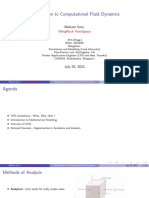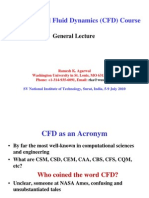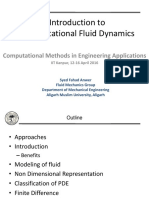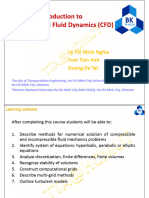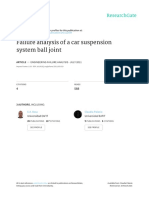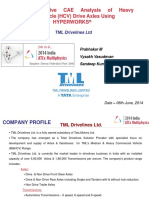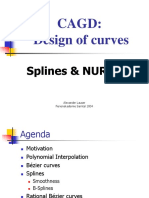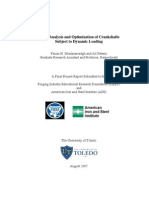Lecture 1
Uploaded by
subha_aeroLecture 1
Uploaded by
subha_aeroComputational Fluid Dynamics I
http://users.wpi.edu/~gretar/me612.html
Computational Fluid Dynamics I
Introduction to Computational Fluid Dynamics-I
Grtar Tryggvason Worcester Polytechnic Institute, Spring 2009
What is CFD A few examples Computational tools Short history Introduction Course goals Course content Schedule Homework and projects Textbooks on reserve
Computational Fluid Dynamics I
Computational Fluid Dynamics I
What is Computational Fluid Dynamics (CFD)?
Finite Difference or Finite Volume Grid
Computational Fluid Dynamics I
Computational Fluid Dynamics I
Grid must be sufciently ne to resolve the ow
The number of grid points (or control volumes) available determines the complexity of the problem that can be solved and the accuracy of the solution
Computational Fluid Dynamics I
Computational Fluid Dynamics I
Bits and Bytes: 64 bits = 8 bytes = one number with ~16 digits precision Memory requirement for 3-D calculations 1003 = 106 10 bytes 10 numbers/node = 0.1 GB 2003 = 8 106 10 bytes 10 numbers/node ~ 1 GB 10003 = 109 10 bytes 10 numbers/node ~ 100 GB FLOPS (Floating-point operations per second) CRAY-1 (1976) - 133 Megaops ASCI White (2000) - 12.28 Teraops Increase by a million in a quarter century !!
CFD is used by many different people for many different things Industrial problems: The goal is generally to obtain data (quantitative and qualitative) that can be used in design of devices or processes. Often it is necessary to use subgrid or closure models for unresolved processes Academic problems: The goal is to understand the physical aspects of the process, often the goal is to construct subgrid or closure models for industrial computations
Computational Fluid Dynamics I
Computational Fluid Dynamics I
A few random examples
CFD is now a standard part of the toolkit used both in scientic studies and engineering predictions The numerical solution yields the velocity and pressure eld everywhere. Usually, it is the force on a boundary that is of interest. Looking at the ow eld can, however, be very informative
Bubble Movie
Computational Fluid Dynamics I
Computational Fluid Dynamics I
Many website contain information about uid dynamics and computational uid dynamics specically. Those include CFD Online: An extensive collection of information but not always very informative http://www.cfd-online.com/ eFluids.com is a monitored site with a large number of uid mechanics material http://www.e-uids.com/ NASA site with CFD images http://www.nas.nasa.gov/SC08/images.html
Computational Fluid Dynamics I http://users.wpi.edu/~gretar/me612.html
Computational Fluid Dynamics I Short history Numerical Approximations
Computing pi, Gauss, etc.
Richardson (1910)
Short History of CFD
Early vision of the role of numerical predictions
Courant, Friedrichs, and Lewy (1928)
Stability analysis of the advection equation (CFL condition)
von Neumann
Role of computations, stability analysis
Lax and the Courant group
Promoting numerical computations
Harlow and the Los Alamos group
MAC, CIC, and other methods
Spalding and industrial applications
CHAM was the first provider of general-purpose CFD software. The original PHOENICS appeared in 1981.
NCAR and the Supercomputer Centers
Computational Fluid Dynamics I
Computational Fluid Dynamics I
Early papers about solutions of the Navier-Stokes equations F. H. Harlow and J. E. Fromm, Computer Experiments in Fluid Dynamics: Scientic American, Vol. 212, No. 3, 104 (1965). F. H. Harlow, J. P. Shannon, and J. E. Welch, Liquid Waves by Computer Science 149 (1965), 1092. D.B. Spalting, Int. J. Numer. Meth. Engr. 4 (1972), 1972
1963: J. E. Fromm and F. H. HarIow, Numerical Solution of the Problem of Vortex Street Development: Phys. Fluids 6, 975.
Computational Fluid Dynamics I http://users.wpi.edu/~gretar/me612.html
Computational Fluid Dynamics I Short history CHAM (Concentration Heat And Momentum) founded in 1974 by Prof. Brian Spalding was the rst provider of generalpurpose CFD software. The original PHOENICS appeared in 1981. The rst version of the FLUENT code was launched in October 1983 by Creare Inc. Fluent Inc. was established in 1988. STAR-CD's roots go back to the foundation of Computational Dynamics in 1987 by Prof. David Gosman, The original codes were relatively primitive, hard to use, and not very accurate.
Commercial Codes
Computational Fluid Dynamics I
Computational Fluid Dynamics I
What to expect and when to use commercial package: The current generation of CFD packages generally is capable of producing accurate solutions of simple ows. The codes are, however, designed to be able to handle very complex geometries and complex industrial problems. When used with care by a knowledgeable user CFD codes are an enormously valuable design tool. Commercial CFD codes are rarely useful for state-of-theart research due to accuracy limitations, the limited access that the user has to the solution methodology, and the limited opportunities to change the code if needed
Major current players include Ansys (Fluent and other codes) http://www.uent.com/ http://www.ansys.com/ adapco: (starCD) http://www.cd-adapco.com/ Others CHAM: CFD2000:
http://www.cham.co.uk/ http://www.adaptive-research.com/
Computational Fluid Dynamics I
Computational Fluid Dynamics I
Computational Resources
Computational Fluid Dynamics has traditionally been one of the most demanding computational application. It has therefore been the driver for the development of the most powerful computers
Single processor computers Vector computers (80s) Parallel computers (90s) Shared Memory Distributed Memory
Computational Fluid Dynamics I Worlds fastest computers
Computational Fluid Dynamics I http://users.wpi.edu/~gretar/me612.html
For up-to-date information about the Worlds fastest computers, see: http://www.top500.org/ http://www.top500.org/list/2008/11/100 Images: http://www.cisl.ucar.edu/computers/bluere/gallery.jsp http://www.nas.nasa.gov/News/Images/columbia_2.html
Introduction to Computational Fluid DynamicsII
Grtar Tryggvason Worcester Polytechnic Institute, Spring 2009
Computational Fluid Dynamics I
Computational Fluid Dynamics I Instructor Prof. Gretar Tryggvason
What is CFD A few examples Computational tools Short history Introduction Course goals Course content Schedule Homework and projects Textbooks on reserve
Ph.D. Brown University 1985 Professor of Mechanical Engineering University of Michigan 1985-2000 since 2000
Professor and Head, Mechanical Engineering Worcester Polytechnic Institute
Short term visiting/research positions: Courant, Caltech, NASA Glen, University of Marseilles, University of Paris VI Fellow of the American Physical Society and the American Society of Mechanical Engineers Associate Editor of the International Journal of Multiphase Flow Editor-in-chief of the Journal of Computational Physics
Computational Fluid Dynamics I Coarse Goals: Learn how to solve the Navier-Stokes and Euler equations for engineering problems using both customized codes and a commercial code Hear about various concepts to allow continuing studies of the literature. Ways: Detailed coverage of selected topics, such as: simple nite difference methods, accuracy, stability, etc. Short introduction to FLUENT Rapid coverage of other topics, such as: multigrid, monotone advection, unstructured grids.
Computational Fluid Dynamics I
Using CFD to solve a problem: Preparing the data (preprocessing): Setting up the problem, determining ow parameters and material data and generating a grid. Solving the problem
Analyzing the results (postprocessing): Visualizing the data and estimating accuracy. Computing forces and other quantities of interest.
Computational Fluid Dynamics I
Computational Fluid Dynamics I
CFD is an interdisciplinary topic Background needed: Numerical Analysis Fluid Mechanics Undergraduate Numerical Analysis and Fluid Mechanics Graduate Level Fluid Mechanics (can be taken concurrently). Basic computer skills. We will use MATLAB for some of the homework.
CFD
Computer Science
Computational Fluid Dynamics I Course outline Part I A brief introduction to CFD and review of uid mechanics Part II Standard Numerical Analysis of partial differential equations Part III Advanced topics in CFD Course homepage: http://users.wpi.edu/~gretar/me612.html
Computational Fluid Dynamics I Course outlinePart I Introduction, what is CFD, examples, computers, elementary numerical analysis, course administration Elementary numerical analysis, integration of ordinary differential equations Elementary numerical analysis, accuracy, stability, partial differential equations Review of uid mechanics: the governing equations Finite Difference solution of the Navier-Stokes Equations in vorticity/streamfunction form Introduction to Commercial CFD codes. Using commercial codes
Computational Fluid Dynamics I Course outlinePart II First order Partial Differential Equations (PDF's). Characteristics. Classication of Second Order PDF's. Algorithms for Hyperbolic equations. Shock captuting. The Euler equations. Algorithms for Parabolic equations.
Computational Fluid Dynamics I Course outlinePart III Complex Domains. Body tted Coordinates. Complex Domains. Grid Generation Introduction to Turbulence, Multiphase ow, and combustion Parallel Computations, Visualization
Algorithms for Elliptic equations. Direct Numerical Simulations of Multiphase Flows Putting it together, solving the Navier-Stokes Equations in Primitive Variables, the MAC Method
Computational Fluid Dynamics I
Computational Fluid Dynamics I
Class hours: MW 6:30pm 7:50pm, HL 116 Each lecture consists of three 25 minutes (or so) sessions Lecture material will be available on the web and will be handed out in class The homework consists of problem sets (about one per class) and four computer projects.
Grading: Four projects, homework, two quizzes. Collaborations You are free to discuss the homework problems and the projects with your fellow students, but your solution should be your own work.
Computational Fluid Dynamics I Project 1 Integrate one-dimensional PDE in time Project 2 Using FLUENT to solve the Navier-Stokes equations in a given geometry, OR a student proposed problem Project 3 Solving the Euler equations (1D) Project 4 Solve the Navier-Stokes equations in the primitive variables (pressure and velocity) for a given 2D geometry
Computational Fluid Dynamics I Textbooks (On Reserve in the Library): Ferziger, J. H. and Peric, M., Computational Methods for Fluid Dynamics, Springer, 1999. Hirsch, C., Numerical Computation of Internal and External Flows, I and II, Wiley, 1988. Tannehill, J. C., Anderson, D. A., and Pletcher, R. H. Computational Fluid Mechanics and HeatTransfer, 2nd ed., Tayler and Francis, 1997. Wesseling, P., Principles of Computational Fluid Dynamics, Springer 2000 Ferziger, J. H., Numerical Methods for Engineering Application, Wiley, 1981 Peyret, R. and Taylor, T. D., Computational Methods for Fluid Flow, Springer, 1983. Patankar, S. V., Numerical Heat Transfer and Fluid Flow, McGraw-Hill, 1980
Computational Fluid Dynamics I http://users.wpi.edu/~gretar/me612.html
Computational Fluid Dynamics I Objectives:
Elementary Numerical Analysis: Finite Difference Approximations-I
Grtar Tryggvason Worcester Polytechnic Institute, Spring 2009
Introduce the basic concepts needed to solve a partial differential equation using nite difference methods. Discuss basic time integration methods, ordinary and partial differential equations, nite difference approximations, accuracy. Show the implementation of numerical algorithms into actual computer codes.
Computational Fluid Dynamics I Outline Time integration of an ordinary differential equation Integration methods Matlab code Error analysis Solving partial differential equations Finite difference approximations The linear advection-diffusion equation Matlab code Accuracy and error quantication Stability Consistency Multidimensional problems Steady state Solving the Navier-Stokes equations
Computational Fluid Dynamics I
Integration of Ordinary Differential Equations in Time
Computational Fluid Dynamics I
Computational Fluid Dynamics I Time Integration A numerical solution of
Integrating a rst-order ordinary differential equation in time
df = g(t, f ) dt
consists of discrete values of f at discrete times
df = g(t, f ) dt
The initial condition must also be specied
f 0 = f (t0 )
f 1 = f (t0 + t )
f 2 = f (t0 + 2 t )
f n1 = f ( t t )
f n = f (t ) f n1 f n
f n+1 = f ( t + t ) f n+1
Time
f (to ) = f o
f0
t0
t t t t + t t t
Computational Fluid Dynamics I Time Integration Start with
Computational Fluid Dynamics I Time Integration To advance:
df = g(t, f ) dt
rearrange
df = g( f , t ) dt
= fn+
Integrate: f
n +1
df = g(t, f )dt
integrate
n +1 t + t
t + t t
g( f , ) d
df =
n
g( , f )d
t t + t
gn
g n+1
g( t )
Need to approximate
this area to evaluate
the integral
f n +1 f n =
g( , f )d
t
t + t
Computational Fluid Dynamics I Time Integration Approximate:
Computational Fluid Dynamics I Time Integration Approximate:
t + t t
g( f , ) d g( t )t = g n t
n n
t + t t
g( f , ) d g( t + t )t = g n +1t
n n+1
n+1
= f + g t
Forward Euler
n+1
= f +g
Backward Euler
g
gn
g( t )
g
g
n+1
g( t )
t + t
t + t
Computational Fluid Dynamics I Time Integration Approximate: Summary:
Computational Fluid Dynamics I Time Integration
t + t t
g( f , ) d
f n+1 = f n +
g
1 n ( g + gn+1 )t 2
g
n
1 1 ( g( t ) + g(t + t ))t = (g n + g n +1 )t 2 2
Trapezoidal rule
Forward Euler
f n + 1 = f n + g n t
Backward Euler
f n + 1 = f n + g n + 1 t
n+1
g( t )
Trapezoidal Rule
f n+1 = f n +
1 n ( g + gn+1 )t 2
t + t
Computational Fluid Dynamics I
Computational Fluid Dynamics I Accuracy Take giving
g( f , t ) = f
df = f dt
f (0) = 1
Example
If the initial condition is
the exact solution is
f (t ) = e t
Computational Fluid Dynamics I Accuracy Forward Euler
Computational Fluid Dynamics I A short code, using matlab (EX1) % a simple code for several integration methods nstep=5;dt=0.5; f1=zeros(nstep,1);f2=zeros(nstep,1); f3=zeros(nstep,1); fex=zeros(nstep,1); t=zeros(nstep,1); t(1)=0;f1(1)=1;f2(1)=1;f3(1)=1;fex(1)=1; for i=2:nstep f1(i)=f1(i-1)-dt*f1(i-1); %Forward Euler f2(i)=f2(i-1)/(1.0+dt); %Backward Euler f3(i)=f3(i-1)*(1.0-0.5*dt)/(1.0+0.5*dt); %Trapezoidal Rule t(i)=t(i-1)+dt; fex(i)=exp(-t(i)); end; plot(t,f1);hold on;plot(t,f2,'r');plot(t,f3,'k'); plot(t,fex, 'r', 'linewidt',3); set(gca,'fontsize',24,'linewidt',2);
n+1
= f f t
n+1
= (1 t ) f fn (1 + t )
Backward Euler
f n + 1 = f n f n + 1 t
Trapezoidal Rule
f n+1 =
n+1
= f
t n ( f + f n+1) 2
f n+1 =
(1 t ) n f (1 + t )
Computational Fluid Dynamics I
Computational Fluid Dynamics I
df = f dt
t=0.5
1 Forward Euler 0.8 Backward Euler Exact
Clearly the numerical solutions have the same behavior as the exact solution but only the trapezoidal rule results in numerical values that are approximately the same. The obvious question is:
0.6 0.4 0.2 0 0 0.5 1 Time 1.5
f = e t
Trapezoidal rule
Can we improve the accuracy of the forward and backward Euler method? Re-run the forward Euler method with smaller time steps
Computational Fluid Dynamics I
Computational Fluid Dynamics I
Forward Euler Method
1 0.8 0.6
Accuracy, effect of t t=0.5 t=0.25 t=0.125 Exact
The error at t=2.5, for the forward Euler Method, dened by: E =| fnum(2.5)-exp(-2.5) | t 0.5 0.25 0.125 0.0625 0.03125 E 0.0728 0.0303 0.0139 0.0067 0.0033
f
0.4 Notice that the
results are
plotted versus
time, not time
step n!
0.2 0 0 0.5 1
f = e t
1.5 Time
2.5
Computational Fluid Dynamics I
Computational Fluid Dynamics I
E=| fnum(2.5)-exp(-2.5) | 0.08 0.06 As the time step becomes smaller, it is clear that the error goes to zero E 0.04 0.02 0 0 Forward Euler + Backward Euler Trapezoidal rule
Error Analysis
0.1
0.2
0.3 t
0.4
0.5
Computational Fluid Dynamics I Exact
Computational Fluid Dynamics I
Analyze the error in evaluating the integral using a Taylor series Expand g
f n +1 = f n +
t + t t
g( f , ) d
dg g = gn + + dt
Approximate the integral
substitute
t + t t
gd =
t + t
t + t t
g n d +
t + t t
dg n d + dt
gdt = g t + dt
t
t + t
n dg t 2 + 2
integrate
n t
f n + 1 = f n + g n t + O( t 2 )
Error at each time step
gdt = g t + dt
n dg t 2 + 2
Computational Fluid Dynamics I
Computational Fluid Dynamics I
f n + 1 = f n + g n t + O( t 2 )
The error at each time step is important, but it is the total error, when integrating over a given time period T that is most important. If the number of time steps is N, the total error is
If the error is of n-th. order:
1 E = Ct n = C t
Taking the log:
E = N O( t )
Since the number of time steps is N=T/ t:
1 n = ln C n ln 1 ln E = ln C t t
On a log-log plot, the E versus 1/t curve should therefore have a slope of -n
E=
T O( t 2 ) = O( t ) t
First Order Method
Computational Fluid Dynamics I
Computational Fluid Dynamics I Summary
Plot the log of the Error versus log of (1/t)
10-1 10
-2
Error at t=2.5 for different t 1 1 Integration of an ordinary differential equation (ODE) in time Implementation in a MATLAB code
-3 E 10
1 2 Error analysis Forward Euler + Backward Euler + Trapezoidal rule
10
-4
10-5 0 10
101 1/ t
102
You might also like
- Fluid Flow: Introduction To Computational Fluid DynamicsNo ratings yetFluid Flow: Introduction To Computational Fluid Dynamics11 pages
- Computational Fluid Dynamics For Incompressible FlowsNo ratings yetComputational Fluid Dynamics For Incompressible Flows43 pages
- Lecture On Computatiional Fluiid DynamiicsNo ratings yetLecture On Computatiional Fluiid Dynamiics48 pages
- Outline: MEEG 512X: Computational Fluid Dynamics Lecture 1: IntroductionNo ratings yetOutline: MEEG 512X: Computational Fluid Dynamics Lecture 1: Introduction10 pages
- Computational Fluid Dynamics And: Marine ApplicationsNo ratings yetComputational Fluid Dynamics And: Marine Applications64 pages
- Introduction To Computational Fluid DynamicsNo ratings yetIntroduction To Computational Fluid Dynamics34 pages
- Physical Problem: General Introduction: Historical Background and Spectrum of ApplicationsNo ratings yetPhysical Problem: General Introduction: Historical Background and Spectrum of Applications6 pages
- Computational Fluid Dynamics (CFD) Course: General LectureNo ratings yetComputational Fluid Dynamics (CFD) Course: General Lecture37 pages
- Computational Fluid Dynamics (CFD) & Its Applications: Prasad N. KulkarniNo ratings yetComputational Fluid Dynamics (CFD) & Its Applications: Prasad N. Kulkarni38 pages
- Introduction To Computational Fluid Dynamics: December 2010No ratings yetIntroduction To Computational Fluid Dynamics: December 201015 pages
- Computational Fluid Dynamics (CFD) - Markus Peer RumpfkeilNo ratings yetComputational Fluid Dynamics (CFD) - Markus Peer Rumpfkeil29 pages
- Computational Fluid Dynamic Nptel NotesNo ratings yetComputational Fluid Dynamic Nptel Notes32 pages
- Computional Fluid Dyanimics (CFD) : Dr. Naveen G. Patil Assistant Professor Ajeenkya Dy Patil Innovation UniversityNo ratings yetComputional Fluid Dyanimics (CFD) : Dr. Naveen G. Patil Assistant Professor Ajeenkya Dy Patil Innovation University38 pages
- Introduction To Computational Fluid Dynamics: Dmitri KuzminNo ratings yetIntroduction To Computational Fluid Dynamics: Dmitri Kuzmin34 pages
- Introduction To Computational Fluid Dynamics: Dmitri Kuzmin100% (1)Introduction To Computational Fluid Dynamics: Dmitri Kuzmin34 pages
- Computational Fluid Dynamics 1st Edition by Naser Sayma ISBN download100% (3)Computational Fluid Dynamics 1st Edition by Naser Sayma ISBN download50 pages
- Introduction To Computational Fluid Dynamics - SF AnwerNo ratings yetIntroduction To Computational Fluid Dynamics - SF Anwer23 pages
- What You Will Learn ?: Solving Fluid Dynamics Problems Solving Fluid Dynamics ProblemsNo ratings yetWhat You Will Learn ?: Solving Fluid Dynamics Problems Solving Fluid Dynamics Problems9 pages
- Introduction To Computational Fluid Dynamics: Course Notes (CFD 4)No ratings yetIntroduction To Computational Fluid Dynamics: Course Notes (CFD 4)24 pages
- Introduction To Computational Fluid Dynamics (CFD)No ratings yetIntroduction To Computational Fluid Dynamics (CFD)134 pages
- Introduction To Computational Fluid Dynamics Lecture 2: CFD IntroductionNo ratings yetIntroduction To Computational Fluid Dynamics Lecture 2: CFD Introduction18 pages
- Chapter 1: CFD Introduction: Dr. Salvador Vargas DíazNo ratings yetChapter 1: CFD Introduction: Dr. Salvador Vargas Díaz12 pages
- Controller of Examinations: M.E. Electronics and Communication Engineering (Industry Integrated) BranchNo ratings yetController of Examinations: M.E. Electronics and Communication Engineering (Industry Integrated) Branch48 pages
- A Design Approach & Selected Wind-Tunnel Results at High Subsonic Speeds For Wing-Tip Mounted Winglets PDFNo ratings yetA Design Approach & Selected Wind-Tunnel Results at High Subsonic Speeds For Wing-Tip Mounted Winglets PDF33 pages
- Applications of Finite Element Stress Analysis of Heavy Truck Chassis: Survey and Recent DevelopmentNo ratings yetApplications of Finite Element Stress Analysis of Heavy Truck Chassis: Survey and Recent Development6 pages
- Arithmetic Processor For Solving Tridiagonal Systems of Linear EquationsNo ratings yetArithmetic Processor For Solving Tridiagonal Systems of Linear Equations5 pages
- A Design Approach & Selected Wind-Tunnel Results at High Subsonic Speeds For Wing-Tip Mounted WingletsNo ratings yetA Design Approach & Selected Wind-Tunnel Results at High Subsonic Speeds For Wing-Tip Mounted Winglets5 pages
- Numerical Analysis of Bridge Aerodynamics: Guido Morgenthal Maunsell Consultants Asia LTD., Hong Kong, ChinaNo ratings yetNumerical Analysis of Bridge Aerodynamics: Guido Morgenthal Maunsell Consultants Asia LTD., Hong Kong, China12 pages
- Failure Analysis of A Car Suspension System Ball JointNo ratings yetFailure Analysis of A Car Suspension System Ball Joint8 pages
- Analysis Information of Powertrain ComponentsNo ratings yetAnalysis Information of Powertrain Components21 pages
- Cagd: Design of Curves: Splines & NURBSNo ratings yetCagd: Design of Curves: Splines & NURBS61 pages
- Fluid Flow: Introduction To Computational Fluid DynamicsFluid Flow: Introduction To Computational Fluid Dynamics
- Computational Fluid Dynamics For Incompressible FlowsComputational Fluid Dynamics For Incompressible Flows
- Outline: MEEG 512X: Computational Fluid Dynamics Lecture 1: IntroductionOutline: MEEG 512X: Computational Fluid Dynamics Lecture 1: Introduction
- Computational Fluid Dynamics And: Marine ApplicationsComputational Fluid Dynamics And: Marine Applications
- Physical Problem: General Introduction: Historical Background and Spectrum of ApplicationsPhysical Problem: General Introduction: Historical Background and Spectrum of Applications
- Computational Fluid Dynamics (CFD) Course: General LectureComputational Fluid Dynamics (CFD) Course: General Lecture
- Computational Fluid Dynamics (CFD) & Its Applications: Prasad N. KulkarniComputational Fluid Dynamics (CFD) & Its Applications: Prasad N. Kulkarni
- Introduction To Computational Fluid Dynamics: December 2010Introduction To Computational Fluid Dynamics: December 2010
- Computational Fluid Dynamics (CFD) - Markus Peer RumpfkeilComputational Fluid Dynamics (CFD) - Markus Peer Rumpfkeil
- Computional Fluid Dyanimics (CFD) : Dr. Naveen G. Patil Assistant Professor Ajeenkya Dy Patil Innovation UniversityComputional Fluid Dyanimics (CFD) : Dr. Naveen G. Patil Assistant Professor Ajeenkya Dy Patil Innovation University
- Introduction To Computational Fluid Dynamics: Dmitri KuzminIntroduction To Computational Fluid Dynamics: Dmitri Kuzmin
- Introduction To Computational Fluid Dynamics: Dmitri KuzminIntroduction To Computational Fluid Dynamics: Dmitri Kuzmin
- Computational Fluid Dynamics 1st Edition by Naser Sayma ISBN downloadComputational Fluid Dynamics 1st Edition by Naser Sayma ISBN download
- Introduction To Computational Fluid Dynamics - SF AnwerIntroduction To Computational Fluid Dynamics - SF Anwer
- What You Will Learn ?: Solving Fluid Dynamics Problems Solving Fluid Dynamics ProblemsWhat You Will Learn ?: Solving Fluid Dynamics Problems Solving Fluid Dynamics Problems
- Introduction To Computational Fluid Dynamics: Course Notes (CFD 4)Introduction To Computational Fluid Dynamics: Course Notes (CFD 4)
- Introduction To Computational Fluid Dynamics (CFD)Introduction To Computational Fluid Dynamics (CFD)
- Introduction To Computational Fluid Dynamics Lecture 2: CFD IntroductionIntroduction To Computational Fluid Dynamics Lecture 2: CFD Introduction
- Chapter 1: CFD Introduction: Dr. Salvador Vargas DíazChapter 1: CFD Introduction: Dr. Salvador Vargas Díaz
- Controller of Examinations: M.E. Electronics and Communication Engineering (Industry Integrated) BranchController of Examinations: M.E. Electronics and Communication Engineering (Industry Integrated) Branch
- A Design Approach & Selected Wind-Tunnel Results at High Subsonic Speeds For Wing-Tip Mounted Winglets PDFA Design Approach & Selected Wind-Tunnel Results at High Subsonic Speeds For Wing-Tip Mounted Winglets PDF
- Applications of Finite Element Stress Analysis of Heavy Truck Chassis: Survey and Recent DevelopmentApplications of Finite Element Stress Analysis of Heavy Truck Chassis: Survey and Recent Development
- Arithmetic Processor For Solving Tridiagonal Systems of Linear EquationsArithmetic Processor For Solving Tridiagonal Systems of Linear Equations
- A Design Approach & Selected Wind-Tunnel Results at High Subsonic Speeds For Wing-Tip Mounted WingletsA Design Approach & Selected Wind-Tunnel Results at High Subsonic Speeds For Wing-Tip Mounted Winglets
- Numerical Analysis of Bridge Aerodynamics: Guido Morgenthal Maunsell Consultants Asia LTD., Hong Kong, ChinaNumerical Analysis of Bridge Aerodynamics: Guido Morgenthal Maunsell Consultants Asia LTD., Hong Kong, China
- Failure Analysis of A Car Suspension System Ball JointFailure Analysis of A Car Suspension System Ball Joint











